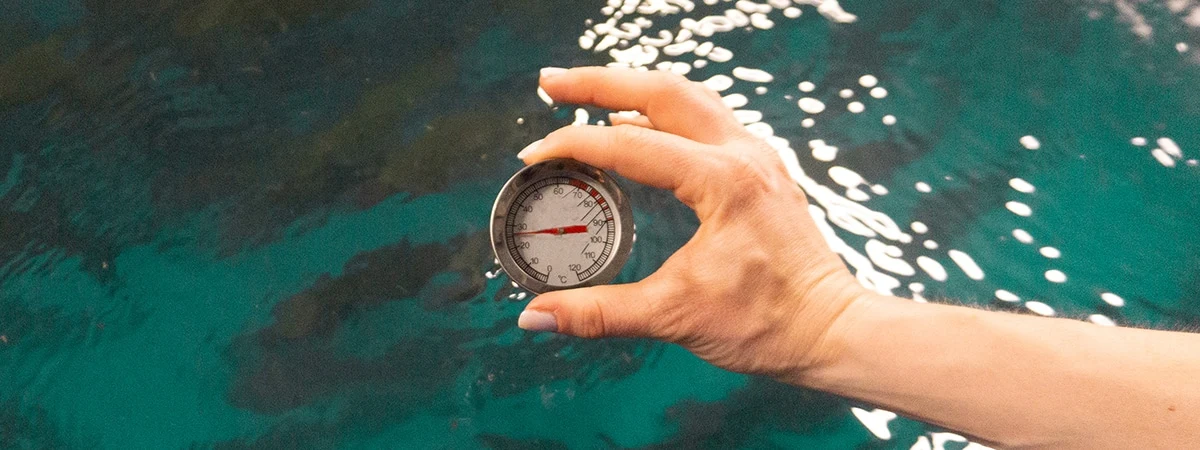Water temperature in recirculation systems

Water temperature is an important parameter to control in recirculating systems. It has various effects on the water quality and the well-being of the animals. Since fish are cold-blooded animals, their body temperature is not constant, but is determined by the environment. In the following blog post we will explain how water temperature affects the system in closed aquaculture systems and what measures can be taken to regulate it.
Effects of water temperature on aquaculture systems
The most important relationship is between temperature and oxygen content. Fish need a minimum concentration of dissolved oxygen in the water to live. The dissolved oxygen is given as a percentage. Depending on the fish species, 50% can be sufficient (e. g. African catfish). For sea bass, however, the value should always be 80–100%. As the water temperature increases, the solubility of oxygen in the water decreases. Therefore, at 0°C, 100% saturation means about 15 mg O2/l (a. d.) dissolved oxygen. This means that the value at 0°C is almost twice as high as at 20°C, with about 9 mg O2/l (a. d.) dissolved at 100% saturation. In addition, in warmer waters (e. g. tropical seas) there is often a greater biological oxygen consumption by other aquatic organisms than in cold waters (e. g. mountain streams). It becomes critical for fish at an oxygen saturation of less than 4 mg O2/l.
In addition, the growth of bacteria, viruses and parasites is also influenced by the water temperature. The Van ‚t Hoff equation (later also known as Arrhenius equation) states that reactions occur twice as fast for every 10°C increase in temperature. Colder water inhibits the growth of bacteria, whereas warm water accelerates their metabolism, so that bacteria and viruses multiply particularly quickly here.
The RGT rule also applies to fish growth. The animals grow faster in warm water than in cold water because their metabolism is then accelerated and they convert more energy. This positive effect of warm water is therefore in conflict with the rapid growth of bacteria.
Factors influencing the water temperature
Basically, water is a very good energy store. It has a specific heat capacity four times that of air. Therefore, water takes much longer to adapt to temperature than this. The larger the basin volume, the more slowly the system reacts, i.e. the longer it takes to warm up. The following factors have an influence on the temperature:
- In addition to the ambient air, the electrical units with their waste heat and the animals themselves also have an influence on the water temperature in recirculation systems. In our plant, fish and components contribute around 5 kW of heat to the system.
- The housing of the plant is also relevant for the water temperature. Sufficient insulation of the enclosure or building should be ensured.
- With active ventilation of plants or premises, it can still be realized that cold air remains outside the plant in winter and warm air in summer. (e. g. heat exchanger)
Control and regulation of the water temperature in the tank
The water temperature is monitored with the help of a sensor that displays the current tank temperature live on the control panel. If predefined limit values are exceeded, alarm signals are given so that countermeasures can be taken.
In the SEAWATER Cube, we use various measures to establish an average annual water temperature that is compatible with the species. On the one hand, the condition of the containers with a 10 cm PU insulation of the walls is an important prerequisite to ensure constant temperatures in the water. We can also actively influence the air temperature in the system via an air-to-air heat exchanger, depending on the ambient temperature. Over time, this also has an influence on the water. For the fish species sea bass and dorade, we realize an average water temperature of 23 °C throughout the year. Fish welfare, fish growth and bacterial growth are in the best balance here. For exotic fish species that like to live in warmer water, higher temperatures are also practicable.
When water temperatures are outside the acceptable range of a fish species, feeding is first reduced. On the one hand, this is in response to the fish’s loss of appetite and, on the other hand, the excessive growth of biofilm and undesirable bacteria can be contained. Another measure to regulate water temperature in extreme weather conditions is to use a heat exchanger (e. g. titanium heat exchanger plate) in the water at certain points. In particularly hot areas / seasons the water can be cooled with the help of a cooling unit via the heat exchanger or in cold areas / seasons the water can be heated via the heat exchanger with the help of a heater (or waste heat from other processes). The selective use of heating rods to heat the water would also be possible, but is associated with a high expenditure of electricity and costs and is less efficient than the use of a heat exchanger.
Further information
Learn more about innovative aquaculture in a recirculating system.
References
- Diagnosen und Prognosen aus der LangzeitforschungSeen im Klimawandel.
- Comte, L. and J.D. Olden, Climatic vulnerability of the world’s freshwater and marine fishes. Nature Climate Change, 2017. 7(10): p. 718–722.
- Myers, B.J.E., et al., Global synthesis of the documented and projected effects of climate change on inland fishes. Reviews in Fish Biology and Fisheries, 2017. 27(2): p. 339–361.
- http://www.wasser-wissen.de/abwasserlexikon/s/sauerstoffgehalt_im_wasser.htm, abgerufen am 16.06.21r
- Bundesverband Aquakultur
- Holleman, A.F. et al. „Lehrbuch der Anorganischen Chemie“ 1995, 101. Auflage. Walter de Gruyter, Berlin
- Picture source: SEAWATER Cubes